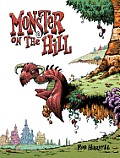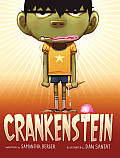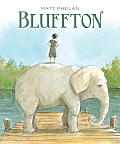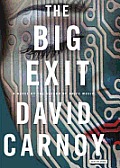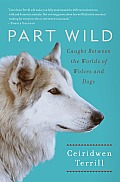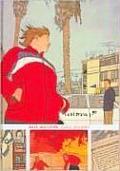Link to this review in the form of a comic strip by geneambaum tagged graphic novel • fantasy • humor
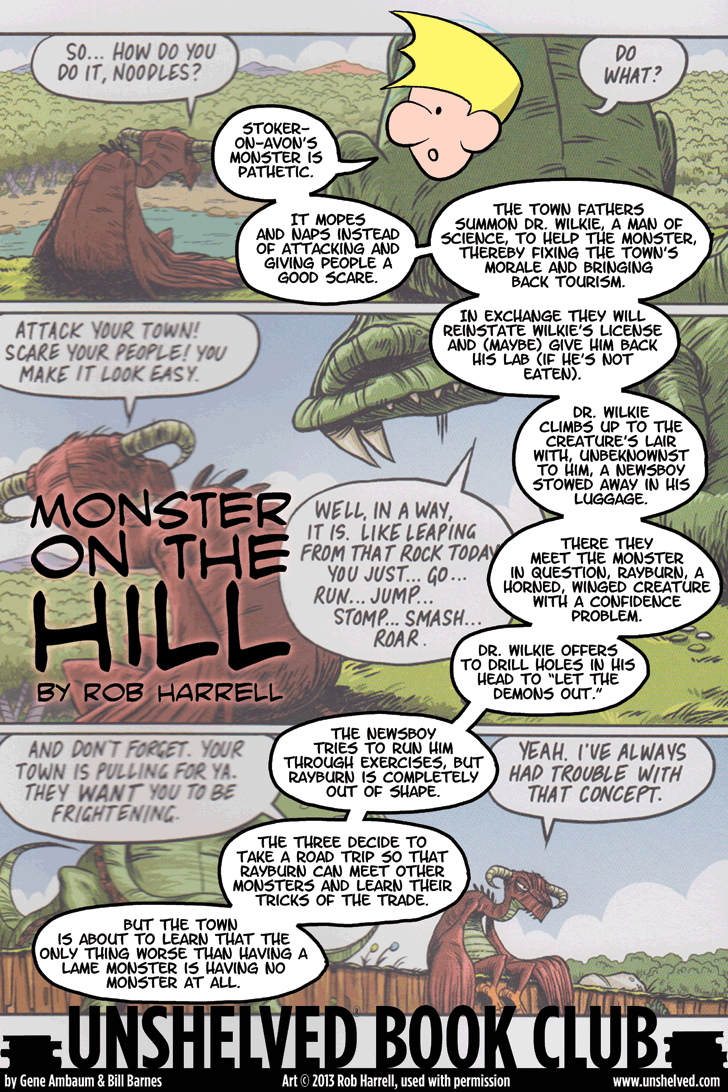
Click for the full-sized comic
@bookblurb Stoker-on-Avon’s pathetic monster goes on a road trip to learn how to give people a good scare.
Link to this review by dawnrutherford tagged picture book
Crankenstein is the little monster unsuspecting parents encounter at the most inopportune times. This book explores frequent sightings and how such a beast might be defused.
Why I picked it up: I really enjoy picture books about monsters. When I saw Dan Santat, the man behind Sidekicks, had illustrated this, I had to read it.
Why I finished it: Santat’s illustrations contrast the sulking, dark, glowering gloom of a cranky kid with the bright, glowing world around them. They really capture the frustration and skewed perspective of a foul mood, when even a huge stack of golden fluffy pancakes can be ruined by a lack of maple syrup.
It’s perfect for: My friend Bryan, who is stuck getting his grumpy, non-morning four-year-old to preschool each day. He is already all too familiar with the “MEHHRRRR” of Crankenstein, and might be able to use this book to help defuse his daughter when she is being ridiculously grouchy.
@bookblurb Frequent sightings of a cranky monster parents will recognize, along with ideas on how to deal with it.
Link to this review by flemtastic tagged alternate history • fantasy • paranormal
Ten-year-old Birdie has a dangerous job. She and her boss, Alfred, are the only ones who can stop the magical creatures that have been snatching children from London’s streets. She is the bait that draws bogles out into the open so that Alfred can spear them, sending them back to wherever they came from. People can be even worse than the bloodthirsty bogles, though, and Alfred and Birdie must deal with attempts to manipulate them for diabolical reasons.
Why I picked it up: Catherine Jinks has had my attention ever since I read about the weak vampires in her book, The Reformed Vampire Support Group. I knew just from the title that her snarky, sarcastic sense of humor would permeate this one, too.
Why I finished it: It’s full of details of Victorian London, and has so much of its jargon that I needed the glossary at the back to help me. I especially loved the names of different monsters Birdie faces: grindylows, fuaths, shellycoats, knuckers, hobyahs, and ciudachs.
Readalikes: Another new book about the supernatural which is also set in Victorian London, The Screaming Staircase by Jonathan Stroud. Both feature brave kids fighting monsters.
@bookblurb Ten-year-old Birdie is the bait that draws child-snatching creatures into the open.
Link to this review by geneambaum tagged graphic novel • historical fiction • biography
In 1908, vaudevillians spent the summer in the Bluffton neighborhood of Muskegon, Michigan. They brought an elephant, a zebra, and many performers, one of whom was a young Buster Keaton. Henry had never heard of vaudeville, but he became friends (and rivals) with Buster, and then started to think he wanted to try performing himself.
Why I picked it up: I’m such a huge fan of Phelan’s The Storm in the Barn that I circled Candlewick’s booth at BEA last year to make sure I was the first one to get a signed copy of this book.
Why I finished it: Phelan’s art really expresses the way Keaton moved, including his father knocking him about on stage for laughs (he was called “the human mop”), the way he snags fly balls, and the story about when a very young Keaton was sucked out a window by a Kansas twister.
Readalikes: Jenni Holm’s Turtle in Paradise, another historical novel about engaging kids who have many strange, funny adventures.
@bookblurb In 1908 vaudevillians, including the young Buster Keaton, take up residence in a small Michigan town.
Link to this review by sarahhunt tagged nonfiction • science
Animals that have to capture, kill, or do something deadly to stay alive have evolved astounding ways to do so, including: high voltage electric eels, box jellyfish with deadly venom, super-fast and super-stabby falcons, and carpenter ants that explode to coat nest invaders with toxic glue.
Why I picked it up: The exploding ant is on the title page!
Why I finished it: It wasn’t only a book of cool facts about animals that you don’t hear from parents or teachers (like how snake venom is made of more than twenty fast-acting toxins that can cause paralysis, heart failure, or even just dissolve flesh), it was also about how we can and why we should share the planet with the less cuddly and more scary parts of nature.
It’s perfect for: A school library display during Shark Week. I immediately thought of the elementary-aged kids I’ve met who would spend hours with this book, sharing the most shocking parts with their friends.
@bookblurb Electric eels. Exploding ants. Stabby falcons. Venomous jellyfish. Sharks won’t be scary anymore.
Link to this review by snow tagged poetry • biography • picture book
Lesley Frost and her family have just moved back to New York City after living in England for two years. They went to England so that her father, Robert, could focus on writing poetry. He published two books in England, but hadn’t gotten paid for them. Now he is worried about how he will support his family in America.
When Lesley’s mother notices a review of one of Robert’s books in a magazine at a newsstand, Robert finds out that one of his collections has been published in America. He rushes off to the publisher’s office to find out more, while his family waits for him at Grand Central Terminal. As they wait, Lesley, the oldest daughter, remembers their childhood adventures on Derry Farm in New Hampshire before the family left for England.
Why I picked it up: I fell in love with Robert Frost’s poetry in high school. He was the first poet who spoke to me in a language that I understood.
Why I finished it: Bober does a brilliant job of arranging it to be both informative and interesting. Rather than writing a straightforward biography (as she did in her book A Restless Spirit: the story of Robert Frost), she focuses on the Frost family’s love of nature, learning, and each other. All of these things are elements a child can understand, and all of them play a part in Frost’s writing. By choosing to have Lesley narrate a flashback, Bober put me right into the story, and I was able to feel Lesley’s happiness.
I was pleasantly surprised by how she included Frost’s poems. The quotations are part of Lesley’s narration, italicized to highlight them. “We learned the names of all the flowers and all the birds. When Papa farmed, we trailed after him, too. At dinner, we shared our stories. You ought to have seen what I saw on my way / To the village, through Patterson’s pasture today: / Blueberries as big as the end of your thumb…” (adapted from Frost’s poem “Blueberries”).
Gibbon’s simple, folk-art style paintings perfectly highlight the Frost family and the beauty of nature. Her color choices are warm and friendly, and a nice complement to Lesley’s cheerful voice.
Bober includes an Author’s Note which told me a little more about the lives of both Robert and Lesley Frost, though she focuses mostly on the happier times, rather than the sadnesses the Frosts faced later in their lives. She also includes quotations from Robert Frost, several of which I plan on keeping in mind as I write, particularly “No surprise for the writer, no surprise for the reader.” Included are the full texts of twelve of Frost’s poems, including two of my favorites, “Mending Wall” and “Dust of Snow.”
It’s perfect for: Sandra, who is positive that poetry is stupid. Lesley and the other Frost children were taught at home, like Sandra is, and loved books as Sandra does. If I read Frost’s poems aloud to Sandra, I think she’ll see the beauty of his words and love him as much as I do.
@bookblurb Lesley tells the story of growing up with her father, the poet Robert Frost.
Link to this review by emilyjones tagged mystery • audiobook
Richie Forman was recently released from prison after serving seven years for vehicular manslaughter. It was a high profile case in which Forman, a Silicon Valley hotshot, was coming home from his bachelor party with best friend and business partner Mark McGregor. Their car hit another, killing the woman driving it. To this day Richie admits to having been drunk but doesn’t believe he was driving.
Now, as he is trying to put his life back together, McGregor’s bludgeoned corpse is found by his wife, Beth, who also happens to be Forman’s ex-fiancée.
Detective Madden believes that Forman had reason to commit the murder, but Beth is also a viable suspect.
Why I picked it up: I listened to the author’s first novel, Knife Music, so his newest audiobook caught my eye. However, when I clicked on the title and realized that I had met the narrator at BEA last year, I absolutely had to check it out!
Why I finished it: I never really knew who I could trust. Bray does a fantastic job of distinguishing the characters (as well as an entertaining “Forman as Sinatra” impersonation) as the plot becomes ever more layered and complex. I was truly second guessing Beth’s and Richie’s motivations.
I also enjoyed the fact that the author threw in some characters from his first novel — while it isn’t necessary to have read it to follow this story, I felt like an insider because I had a history with Detective Madden and his prejudices.
It’s perfect for: Marc, my friend who works in Palo Alto. Carnoy’s brilliantly drawn stereotypes of Silicon Valley up-and-comers will make him laugh, and he’ll be disturbed by the dark underbelly of the high stakes technology business.
@bookblurb Richie was just released after seven years in prison, and now he’s a suspect in his former business partner’s murder.
Link to this review by darcy tagged nonfiction • biography
After leaving an abusive relationship, Terrill adopted a wolf-dog hybrid puppy named Inyo. She moves, attends college, and gets married, and throughout it all she is determined to keep the dog.
Terrill describes four years of mishaps with Inyo, from eating the window trim to becoming more and more aggressive toward other dogs and chickens. She gets frantic, angry calls from neighbors who worry about their livestock, pets, and children, but she always sees the beauty in Inyo, even when others only see a monster.
Why I picked it up: Years ago someone gave my sister a wolf-dog puppy. He was fluffy and grey and cute, but we already had a dog and couldn’t keep him. Sometimes I wonder what happened to him.
Why I finished it: Terrill spent years interviewing geneticists and researchers, and even traveled to Siberia to visit a farm that has been trying to domesticate silver foxes since 1959. (She wanted to see the changes in the foxes that have been bred there.) What kept me turning the pages, though, was her honest and raw admissions about failed relationships and how Inyo fit in to her life.
It’s perfect for: Nina, who works in a vet’s office and rescues animals. She probably would never own a wolf-dog hybrid, but I know she’d recognize pack behavior like numerous puddles of urine from constant territorial marking.
@bookblurb Terrill sees the beauty in her adopted wolf-dog puppy even when others worry he’s a monster.
Link to this review by geneambaum tagged literary • graphic novel
Koby meets a young woman, Numi, who tells him that the unidentified victim of a recent suicide bombing was probably his father. Koby is dubious about the information, but his sister hasn’t heard from him for three months, and his father’s house is empty. When Numi comes clean about her romantic relationship with Koby’s father, and the fact that she saw the scarf she made for him at the scene of the bombing on the news, Koby starts to believe her. But identifying his remains proves more difficult than either of them thought.
Why I picked it up: I heard excellent things about this book when it came out. Modan was a guest at TCAF this year, which reminded me I needed to read it.
Why I finished it: The relationship that develops between Koby and Numi feels real because it’s so nuanced. At first Koby is disgusted by Numi’s relationship with his father, whom Koby doesn’t respect or even like. There are awkward moments, like when Koby finds out Numi visited his mother’s grave with his father because he didn’t like to go there alone. But throughout their time together, they become closer and closer.
It’s perfect for: Anyone who’s read Joe Sacco’s Palestine (about life in and the history of the West Bank and Gaza) or Guy Delisle’s Jerusalem (anecdotes from Delisle’s year living there with his family). This helps round out a view of Israel by showing the daily lives of a rich young woman and a working class young man in Tel Aviv.
@bookblurb Koby and his father’s young lover try to figure out if his dad died in a recent suicide bombing.
